Mario has always been a lovable, carefree character who never holds a grudge against even his greatest adversaries. He’s always willing to go for a round of golf, play some tennis, race around the track, and party with friends and foes alike. The Mario Party series is what kicked off this trend of the cast of Mario getting together to compete in a board game-style competition. While it seemed like a strange departure when the first game came out for a series so focused on running and jumping to spin off into a turn-based game with dice rolling, it turned out to be one of the most successful diversions the Italian plumber ever made.
- 1. Mario Party Superstars Trailer 80 % 4/5 E Platforms Nintendo Switch Genre Card & Board Game Developer Nintendo, NDCube Publisher Nintendo Release October 28, 2021 Read our full Mario Party Superstars review Read more Mario Party Superstars - Announcement Trailer | E3 2021
- 2. Mario Party 2
- 3. Mario Party 3
- 4. Mario Party 4
- 5. Super Mario Party
- 6. Mario Party 8
- 7. Mario Party 6
- 8. Mario Party 7
- 9. Mario Party 5
- 10. Mario Party
- 11. Mario Party DS
- 12. Mario Party 10
- 13. Mario Party 9
- 14. Mario Party: The Top 100
- 15. Mario Party: Island Tour
- 16. Mario Party Advance
- 17. Mario Party: Star Rush
- 18. Mario Party-e
Dating back to the debut on the N64, Mario Party games have appeared on just about every Nintendo console released since. Some sequels are more similar to the original formula of traversing a map via dice rolls, collecting coins and items, playing minigames, and purchasing stars to determine the winner, while others only vaguely resemble that well-loved structure. In the over two decades since we were first invited to this crazy party with Mario and friends, there have been nearly 20 different Mario Party games released. While some are held in extremely high regard, there are more than a few that are seen as downright atrocious. Here’s how we broke down ranking all the best Mario Party games from best to worst.
Further reading
- The best Mario games of all time
- The best Nintendo Switch games for 2021
- The best multiplayer games on Nintendo Switch
1.
Mario Party Superstars
 Platforms
Nintendo Switch
Genre
Card & Board Game
Developer
Nintendo, NDCube
Publisher
Nintendo
Release
October 28, 2021
Read our full Mario Party Superstars review
Platforms
Nintendo Switch
Genre
Card & Board Game
Developer
Nintendo, NDCube
Publisher
Nintendo
Release
October 28, 2021
Read our full Mario Party Superstars review
Mario Party Superstars

The only game that could top even the most nostalgia-blind Mario Party fans who adore the N64 classics above all others is the one that combines the best of all of them into one new and modern package. After Super Mario Party came close to recapturing the feel of the traditional board game style that made the older games the hits they were, and Mario Party: The Top 100 bringing back the best minigames but without that element whatsoever, this title finally brings together the best ideas of those two games into one dream package.
This game should’ve happened years ago, but better late than never. Mario Party Superstars does what fans have been asking for for years and ditches all the weird board gimmicks, different dice types, and stinker minigames and looks back at all the great ones they’ve done and brings them forward onto the Switch. Boards from the original trilogy and games from the entire series are all brought back here, from across the entire franchise, but now with the benefit of much-improved controls, online play, and a great roster of Mario characters to play as. Whether you’re an old-school fan or new to the series, there’s no better way to experience the best Mario Party has to offer.
Read our full Mario Party Superstars review
2. Mario Party 2

Nintendo is a company that doesn’t like to do the same thing twice. This is a methodology that can result in some of the best games the company has produced, as well as some of the worst. In the case of Mario Party 2, they changed only the essentials from the rough draft that was the first game and created an all-time masterpiece. Despite less than a year of development time, this sequel somehow knew what problems the first game had, where it could expand, and what new features would be the most fun. Basically everything fans love about the series was introduced in this game.
Prior to Mario Party 2, there were no items, no duel or battle minigames, and less varied and dynamic boards. Plus, in a touch that is criminally locked to this one game, every character has a unique outfit to fit the theme of the board being played. Want to see cowboy Donkey Kong or pirate Yoshi? This is the only game to do it. Items added a bit of skill and planning to the game otherwise mostly being dictated by the roll of the die, and the minigame selection was not only large but also extremely creative. This is where many of the most iconic games came from, and there’s hardly a bad one in the batch.
3. Mario Party 3

Some consider Mario Party 3 the actual peak of the classic games, and there’s an argument to be made there for sure. It is another iteration of the formula, but more in terms of refinement than actual innovation. Basically, it’s Mario Party 2, but more. Sure, there are new minigames, as there will be in every game, new boards, more items, and ever so slightly improved graphics. Oh, and it also is the debut of Waluigi in the cast, so that alone may make it the top game for you.
What new features it does add are mostly secondary to what we all want from a Mario Party game. A single-player story mode is a nice feature, but who really wants to play this game alone against A.I.? The Duel Mode is better, giving a more tailored experience for when you only have one other friend to play with. The standout items here are the Lucky Lamp, which randomly moves the star’s location on the board, and the Reverse Mushroom, allowing you to backtrack. These do increase the strategy without getting too complex or removing the chaos factor we all love (hate) about the series.
4. Mario Party 4

Our last chronological entry is the first Mario Party released for the next generation of Nintendo consoles, the GameCube. The visuals in Mario Party 4 alone set the standard for what the series would look like, more or less, for years to come. However, looks are only a minor feature in most Nintendo games, especially Mario Party. This entry still doesn’t rock the boat too much, but for better and for worse. The new minigames are certainly fun, still finding new ways to compete that people look back fondly on, but nothing groundbreaking. This is the most smooth and refined one from a gameplay perspective for sure, arguably controlling the best of any game yet.
Where Mario Party 4 falters is in some of the new mechanics it introduces, as well as its board design and selection. The major new mechanics are the mini and mega mushrooms. One shrinks your character, as well as limits the dice numbers to only 1 to 5, and lets you go through very situational mini pathways on the map. Mega mushrooms do about the opposite, where you get big and roll two dice blocks. If you pass other players while big, you steal 10 coins, but you cannot interact with any board events, including stars. The board designs themselves are pretty bland, don’t have much uniqueness among them, and are actually pretty small.
5. Super Mario Party
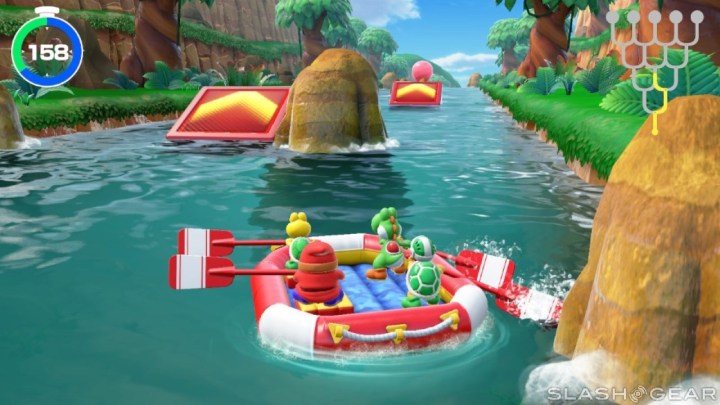
Jumping (see what we did there?) way into the future, we hit Super Mario Party for the Nintendo Switch. This felt like the perfect opportunity for Mario Party to make a comeback after a string of absolutely abysmal entries leading up to it. The Switch felt like it was made for Mario Party, if only Nintendo would go back to what made the series so popular in the first place. In the end, we kind of got the game we were hoping for, but in reality, it felt like a half-measure. After 10 years since the series looked anything like the classic games, most were accepting of this attempt at a return to form.
Super Mario Party strips most of the gimmicks that fans hated over the past few entries and does a decent job of giving us what we wanted. At the same time, despite being the newest game in the franchise, it feels almost like the first in a lot of ways. There’s a criminally small number of boards, all of which are quite small, and only years later was online play added in an update. Most hoped more boards would be added later on, but that never came to pass. The balance is also not particularly good, with star prices slashed and each character having its own dice block, plus the ability to get companions that can really tilt the scale in one player’s favor. It’s a fun enough time but doesn’t have the lasting power we want out of a game like this.
Read our full Super Mario Party review
6. Mario Party 8

Perhaps even more than the Switch, the Nintendo Wii seemed like a slam dunk for a Mario Party title. The motion controls opened up an entirely new design space for creative and fun minigames. Unlike other games using the Wii’s motion controls, it actually served the minigame format perfectly since no game went on long enough for players to get bored or frustrated with the controls. Plus, they still had the option to use more traditional controls to add even more variety. Unfortunately, not all of these minigame ideas turned out to be as fun as they were intended to be.
The boards were also a mixed bag. On one hand, we got really fun and different board types like Koopa’s Tycoon Town, where you invest your coins into hotels to earn stars, but if another player invests more than you, the stars belong to them. This twist was probably the best idea Mario Party 8 had, giving way more control to players to actually plan and gamble when the best time to invest or not would be. On the other hand, you get Goomba’s Booty Boardwalk, which is a literal straight line of a board. It’s a decent entry, but with some pitfalls that hold it back from reaching the potential a Wii Mario Party game should’ve hit.
7. Mario Party 6

Somehow the GameCube got a total of four Mario Party games, with the second-to-last one being Mario Party 6. This is where gimmicks start to influence the core of the games going forward, but they aren’t overly intrusive just yet. The system this game introduces is a universal day and night cycle to all the boards. This was something seen before but was board-specific. Depending on the time of day, boards would have different events, paths, and spaces to keep players on their toes. Depending on how this gels with you, it could raise or lower it on your personal ranking, because the rest of the game is a solid entry.
While it does allow for use of the GameCube’s microphone, we never knew anyone who had one to use, and the minigames themselves don’t require it. The selection here is solid, too. Nothing that would go on to be fondly remembered, but nothing that people loathe. One interesting mechanical twist was related to items now being orbs that players could throw to lay traps on the board. That spiced things up in a way that perfectly fit the series and would be a welcome feature to have as a standard. Boards remained solid, and the day and night cycle did give them some extra room to make them more layered, but they aren’t quite special enough to stick out in our memories.
8. Mario Party 7
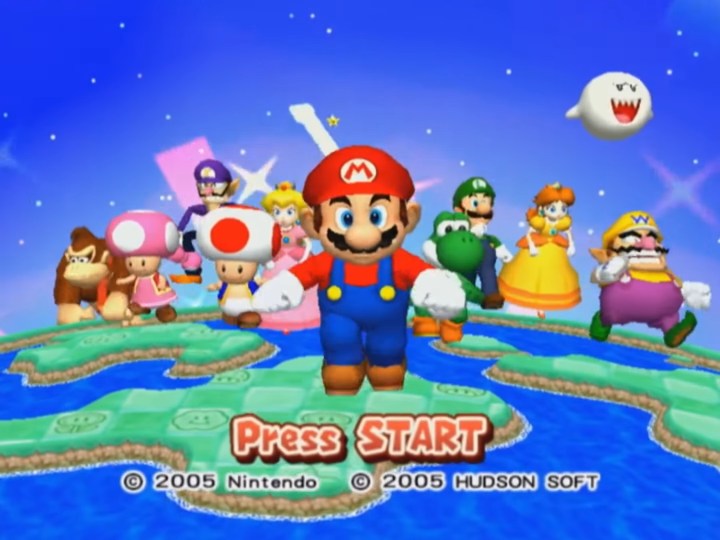
The final Mario Party for the GameCube is also the unfortunate weakest of the four titles. It again dabbled with the microphone, but again to no real consequence. If it does one thing well, it gives you a ton of content. Seriously, this game is absolutely packed with things to do, and if that’s all you’re looking for, then this game isn’t a bad choice. On the other hand, there really isn’t much to say about this game. It just doesn’t do anything particularly noteworthy. Sure, two of the boards were kind of cool in how they changed, but as a package, it’s kind of like a bag of chips. It’s fine, but not a satisfying meal you’d remember fondly.
Aside from a huge list of minigames, Mario Party 7 did try a small innovation with an eight-player mode, but in probably the worst way possible. Because Nintendo does things its own way, it decided to make this eight-player mode have two players share a single controller. The single-player offering is also insultingly slow and boring. There’s plenty of content to unlock playing it via a shop that allowed you to unlock figurines, but the act of doing it just isn’t fun. Speaking of not fun, the gimmick here during Party Cruise mode is Bowser Time, which triggers every five turns. When it does, Bowser appears and does some random act to screw over one or all the players. Bowser is a fun wrench when he’s a single space on the board, but way too frustrating when he appears every five turns.
$60 from Ebay
9. Mario Party 5

We’re about at the halfway point in the list, which is a fitting spot for Mario Party 5. This game is just kind of there. It doesn’t do anything spectacularly bad, but it doesn’t do anything better than average either. It’s just more Mario Party, which is fine, but if you’ve played even the last entry then this one will feel very shallow. The only thing it experimented with was a side mode called Super Duel Mode. In this mode, two players battle against each other by building customizable vehicles called Machines by purchasing parts with points earned through minigames. It’s fun for a round or two but lacks any real depth.
The boards this time around are uninspired and unappealing to look at, the roster is almost identical to Mario Party 4, and most minigames are recycled from the previous game too. All this makes a game that just feels like a drag to play. When you get down to it, there’s no reason to play this game over the previous game, or the next installment. There’s no such thing as a lazy game, but this entry just feels like they were told to make a new Mario Party and didn’t have any spark or ideas that made them actually want to.
10. Mario Party
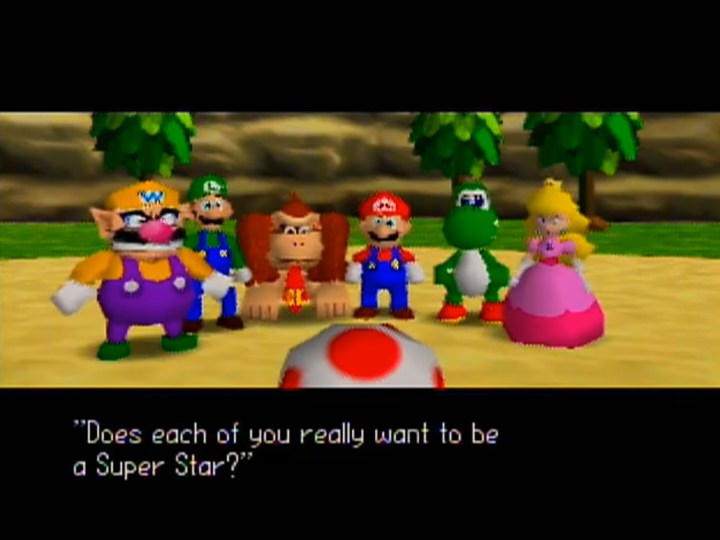
Finally, we come to the original. The first game in the series does have to be acknowledged for kicking off this ridiculous concept in such a way that it managed to thrive long enough to reach the heights we’ve already covered, but at the same time there’s no denying how hard it is to go back to this rickety old game. For a first outing, Mario Party set the standard for the basic formula the best games would improve upon. We got the board-based gameplay, dice rolling, some items, minigames, and many of the iconic spaces. However, playing it can sometimes be painful (literally). There’s hardly any sense of balance here, which is always a delicate tightrope the series has to walk, but the fact that you can lose coins during minigames alone was a terrible choice.
Then there are the minigames. Some went on to be some all-time favorites, such as Bumper Balls and Mushroom Mix-Up, but others ended up requiring Nintendo to ship out special gloves to keep players from tearing the skin on their palms. There was a single-player mode, but it boiled down to simply going through each minigame against A.I. on a set number of lives. There’s also no variety in minigames — they’re all four-player free-for-all style — and the eight boards, while creative, are uninteresting to actually move through. There’s just no reason to go back to this one.
11. Mario Party DS

This is where we really tip the scales into the bad side of the Mario Party games. The formula isn’t completely broken here, but this game clearly had its focus in the wrong areas. Mario Party DS was the only iteration for the console, and perhaps had even more potential than the Wii. For one, the DS had plenty of ways to interact that could make for completely unique minigames using the touch screen, dual-screen, and built-in microphone. The real opportunity here, though, was for online play. The DS, as a handheld, obviously couldn’t support local multiplayer like the console games could, but the idea of going online to play a round of Mario Party seemed like a perfect fit.
Technically, Mario Party DS did do most of those things. It did create a bunch of new minigames, actually having a substantial 73 in total, that used the console’s unique features, and was playable wirelessly with up to four friends, even if only one owned the game itself. However, the game had a disappointing number of boards and was geared more toward the single-player offering, with achievements to go after for unlocks. Perhaps that was to make up for the fact that it was just way more difficult to get a game going when each player had to own their own console. For a handheld attempt, though, it at least got the core mostly right.
12. Mario Party 10
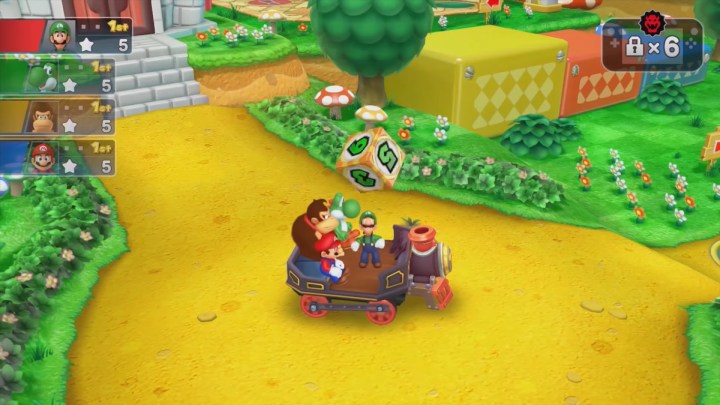
For all the problems there were with the WiiU, and boy were there a ton of problems, the one problem it shouldn’t have had was a bad Mario Party game. Just like the Wii and DS before it, the WiiU’s touchpad opened up nearly endless possibilities for minigames that never could’ve been done before, and yet Nintendo squandered even that. Before even getting into that, the main issue with Mario Party 10 is a holdover from the also maligned Mario Party 9, the car system. We’ll cover that more in the next entry, but just know it’s as frustrating and counterintuitive as ever.
The one thing Mario Party 10 has above 9 is the Bowser Party Mode. This is the only mode that actually utilizes the gamepad to any real extent and is … just all right. It turns the game into a 1v4-style game, with the four normal players still all being stuck together in a stupid car, while the other player is Bowser chasing them. Instead of it being a game about collecting stars, the goal of the regular players is to simply survive until the end of the map, while Bowser tries to deplete their collective hearts before they do. Technically, this does fit the car system better than a normal party mode, and if it were the only place the car system was implemented, would actually be a fine side mode. Instead, they kept the car as the primary mode of play and drove this game off a cliff.
13. Mario Party 9
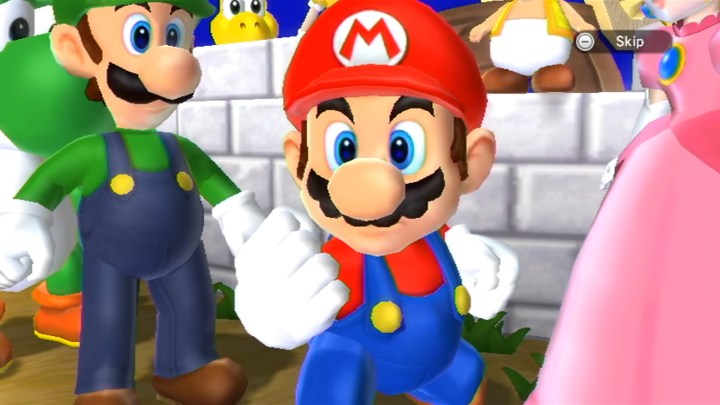
This is it. This is the game to blame for the mind-bogglingly daft decision to take essentially half of what made Mario Party fun and interesting — moving around the boards — and gutted it. Perhaps this was due to Mario Party 9 being the first game developed by NDcube while every other game before was made by Hudson Soft, but either way, Nintendo never should have let this game go past the concept stage with a pitch like the car system. Obviously, such a drastic change in the formula would mean Mario Party 9 couldn’t function like the previous, actually good games did.
With the car, no player moved independently on the board. Everyone moved together, removing all sense of strategy and positioning. That meant that the way stars were collected had to change too and was replaced with things called mini stars and mini ztars. Basically, these were what coins were in past games, with ztars taking away mini stars from your total. Whoever had the most mini stars by the time the car reached the end of the board won. But, because other players moved you around the board and vice versa, there was no way to plan or strategize anything. Things just happened to you in this game, and it never felt like winning or losing was earned.
14. Mario Party: The Top 100

As a concept, Mario Party: The Top 100 sounds like an easy slam dunk. Take the 3DS and pack in the all-time best 100 minigames from the series, making it have the highest number of minigames any game in the series ever had. How do you screw that up? Well, they certainly found a way. The game features three main modes: 100 Minigames, Minigame Island, and Minigame Match, and only one of them utilizes a board game structure. 100 Minigames is basically just a menu where you play the featured minigames one at a time. There’s no progression, no stars, just the game in isolation. Minigame Island sounds more promising but is only single-player. Here you play with an A.I. against another pair of A.I. in 2v2 games.
That leaves Minigame Match, which is the only mode in which you’ll catch a glimpse of a traditional board. But these boards are small, and we mean small. Also, if you thought you would at least be playing in the traditional board game style, guess again. Instead of winning games, earning coins, and buying stars from a select point on the board, you need to pop Star Balloons to collect stars. These are placed around the map, and render the admittedly great minigames useless to the overall game itself. Minigames alone can’t make a great Mario Party, and Mario Party: The Top 100 is proof of that.
15. Mario Party: Island Tour
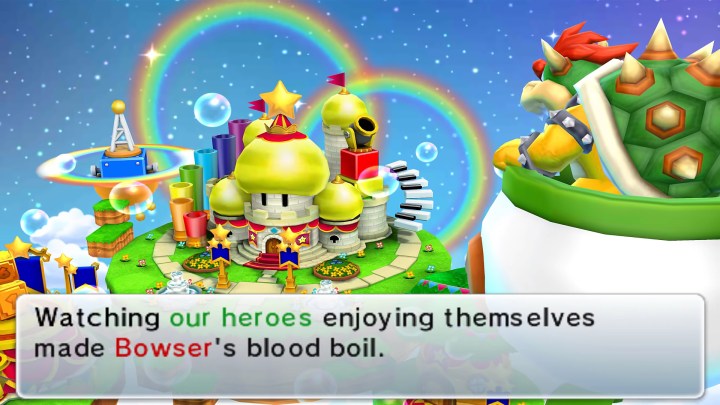
It took six years for Nintendo to give Mario Party another try on handheld after Mario Party DS, and the only lesson Mario Party: Island Tour took from that first attempt was only requiring one person to own the game for a group to play. Thankfully, it does return to the board-based structure, but basically, all the boards had some gimmick to them that made luck corrupt any sense of fun. One board made the last player to reach the end the winner, which isn’t exactly an element under your control. Likewise, most of the minigames also fell into the trap of just rewarding blind luck.
Also being a handheld game, Mario Party: Island Tour is designed to be a much shorter game. Winning minigames doesn’t really make much of a difference in most boards, and while they do try and use the 3DS’s unique control options, actually controlling a lot of the minigames just doesn’t feel good or responsive. Tack on the always persistent problem of needing four consoles to get a full group to play, and Mario Party: Island Tour is no day at the beach.
16. Mario Party Advance

At this point, there’s not much point in spending a lot of time on these almost objectively poor games. Mario Party Advance was the first-ever handheld Mario Party experiment and probably should’ve been the last. The main mode here is called Shroom City, which has you move around a map to complete objectives and collect the minigames and things called Gaddgets in other modes. There is a mostly traditional party mode, with boards, dice, minigames, and everything, but with a major fault: Finding three other friends with GBAs, Mario Party Advance, and link cables. That meant the game was yet another to fall into the trap of being too focused on single-player content. With minigames needing to be so basic on this device, there’s not much to celebrate.
17. Mario Party: Star Rush
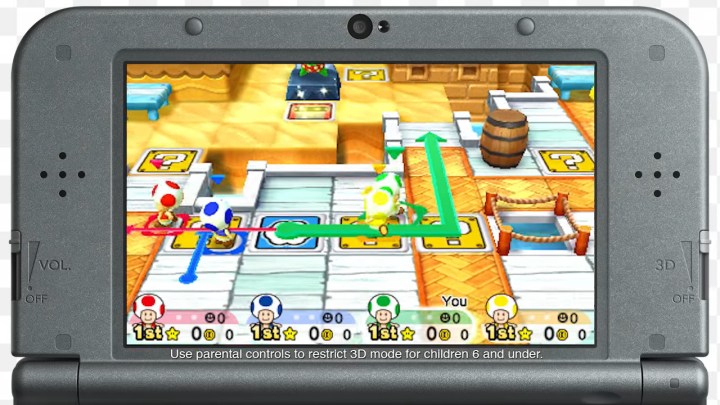
The final 3DS entry for the series on our list is Mario Party: Star Rush. If you guessed that this game would break the cardinal rule of ditching the board game setup, you deserve a star yourself. This main mode on offer here is called Toad Scramble, where there are no turns. Players all move at once, leading to a complete mess of an experience. To earn stars, you would need to win boss minigames by landing on the spaces in front of them on the board, with up to five being present at any one time. Again, if this were a side mode, that’d be fine, or a nice distraction even. Instead, we have that, plus half a dozen other bare-bones modes that all feel half-baked. Speaking of bare-bones, this game has a paltry 53 minigames, which is only three more than the original Mario Party.
18. Mario Party-e

There’s an age-old question: Is a Mario Party game really bad if almost no one is around to play it? The answer is yes. Mario Party-e is probably a game most people never have, and never would without this list, hear about. We’re back on the GBA, so another handheld situation, but with the additional wrinkle of being exclusive to the e-reader attachment. This game — and it almost is more of a traditional game than a videogame — comes with a deck of 64 cards and a playmat. Your goal is to collect three superstar clothes accessories and then the superstar. Really, this boiled down to you playing a card game in real life and occasionally picking up your GBA to play a minigame using a card. At this point, they might as well have just made an actual board game.
Editors' Recommendations
- These are the 10 best gaming PCs I’d recommend to anyone
- Best gaming headset deals: PS5, Xbox and PC
- Best gaming chair deals: Save on Corsair, Razer, and more
- Best video game deals: PlayStation 5, Xbox S and X, Nintendo Switch
- Best Xbox Game Pass deals: Upgrade to Game Pass Ultimate for cheap





